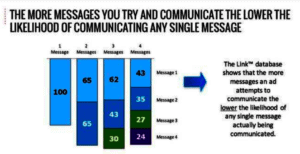
Hook Your Audience in the First 7 Seconds
Hook your audience with a 7-second message.
A Message Map helps you create a clear, concise, compelling message for your organization, business, or brand.
The right place to begin creating your strategic message is with your 7-second, 23-word message. Why?
Because when your CEO or spokesperson gets quoted in news media, chances are, they will get only 7 seconds or 23 words to make their point. That’s the length of an average news media sound bite.
Seven seconds is also a good length for:
- Elevator speech
- Headlines and subheads
- Email subject lines
- Social media posts.
View the 23-word limit as a ceiling, not a floor. You don’t have to use all 23.
Here’s a business networking message that uses only 13 words. It boils down to what buyers need to know when they decide on a complex technology:

Sometimes you won’t get the time to use all 23 words from your Message Map.
For example, when Joe Szabo worked in the Federal Railroad Administration, he was called to testify before Congress.
Here’s how that experience felt: “When you’re asked a question, you might only get 3, 4 words out of your mouth before you were cut off. You often would get no more than one short sentence. So, you really had to make that short sentence count. It had to be a powerful 5, 6 words. Message mapping and preparation allow you to do that.”
Once you hook your audience’s attention with a 7-second message, Message Maps help you scale up your message gracefully to 2 minutes, 20 minutes, or more. So, your message fits any need, any medium, any occasion.
Message Map rules
Message Maps come with a few rules. One is: your home base can convey only one main message – never two or more.
Why? Because if you try to communicate multiple messages, it’s unlikely that audiences will recall your message.
Multiple messages require too much mental effort from audiences. They’re too taxing for people, a Kantar Millward Brown study of advertising shows. That’s why you need to have only one home base, one main message.

To get your message across, focus relentlessly on delivering one singular message, advises cognitive neuroscientist, Dr. Carmen Simon. Trying to make multiple points leads to losing your audiences’ attention.
As Seth Godin says, “If you try to say three things, we will hear nothing. Because most of the time, we’re hardly listening.”
Successful messages do two jobs well: they maximize the promised reward and minimize the effort to gain it. Wilbur Schramm, a pioneer in communications studies at the University of Illinois, created his Fraction of Selection to illustrate this idea:
The reward equals the benefits your audience expects to get. It directly answers the audience’s first question, what’s in it for me?
To get audiences to embrace your message, minimize their effort. How? By learning what are your audiences’ needs and concerns, answering their key questions, and speaking their language. Never talk over their heads. Never talk down to them.
More reward and less effort
More reward and less effort describe the dynamics of successful human communications. To build acceptance of your message, use both of these levers:
· Increase the audience’s expectation of reward.
· Reduce the effort required to attain that reward.
When you repeat your message consistently, it breaks through and gets remembered. Repetition helps messages get through, especially when they maximize reward and minimize effort for the audience.
Gain credibility with consistency
To get audiences to believe you require credibility. Consistency is the path to credibility, Dr. Simon notes. When a strategic message stays consistent, it can earn a spot in the brain’s “place cells,” which never run out of capacity. Since inconsistent messages get stored in short-term memory, they’re likely to be forgotten.
Caution: never, ever promise more rewards than you will actually deliver. For example, “click-bait headlines” promise a bit of information that clicking on them does not reveal. Click-bait is designed to lure in, then disappoint, people.
Overpromising and underdelivering are simply unethical. Yes, certain salespeople and politicians get away with it for a while. But sooner or later, overpromising sets them up for a fall. It hurts them and sullies the reputations of honest people by increasing audiences’ skepticism – hard to imagine, given how skeptical people already are.
With a Message Map, you improve the odds that your message will land on fertile ground and take root. You want audiences to understand, accept and remember your message. People will act only on the messages they remember, not those they forget.
Fortune 500 companies use Message Maps, as do start-ups, small businesses, nonprofits, and government agencies. Over the years, my partners and I have trained thousands of people on how to create and use Message Maps.
With the right 7-second message, your brand:
- Attracts customers with marketing and communications that are consistently on message
- Launches new products successfully
- Introduces a new strategy or a new leader
- Recruits and retains employees
- Increases investors’ confidence in the company
- Builds a reputation in local communities
- Secures approvals for mergers and acquisitions.
Unlock your communications advantage by creating your own Message Map.
Related Posts
How to use a Message Map to succeed in everything
My business partner George Stenitzer and I write frequently about how Message Maps can help your organization get its story heard. In fact, George...
Why You Need to Keep Marketing Messages Simple
What your marketing messages can gain from 3 usability ideas Recently I read a great little e-book on usability called The Ten Commandments of UI Design....
Why your business message needs a message map
I love business message maps. They help you find out where you are, decide where to go, and figure out how to get there. ...
Your Audience’s Bill of Rights
The Audience’s Bill of Rights. See marketing through your audience’s eyes To help you see how marketing looks through the eyes of customers, I...





